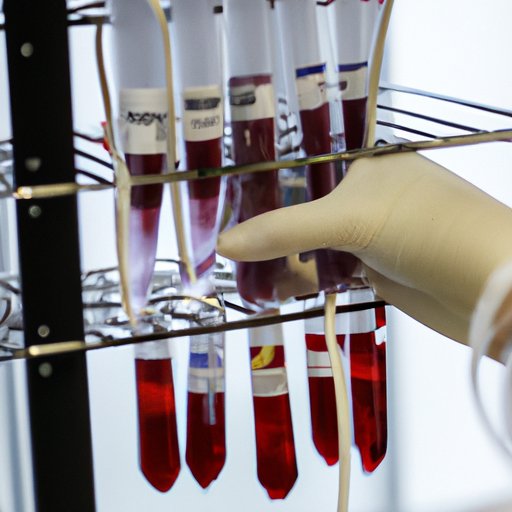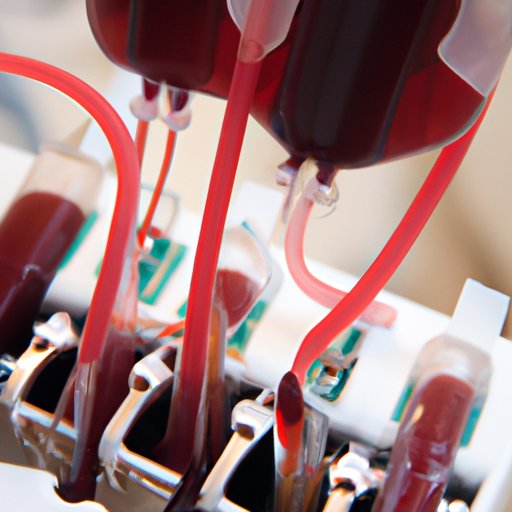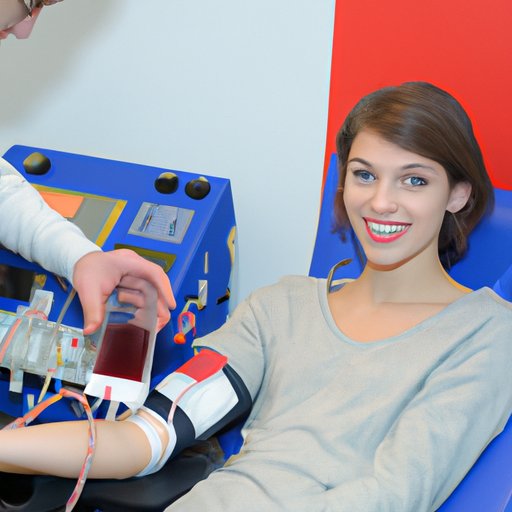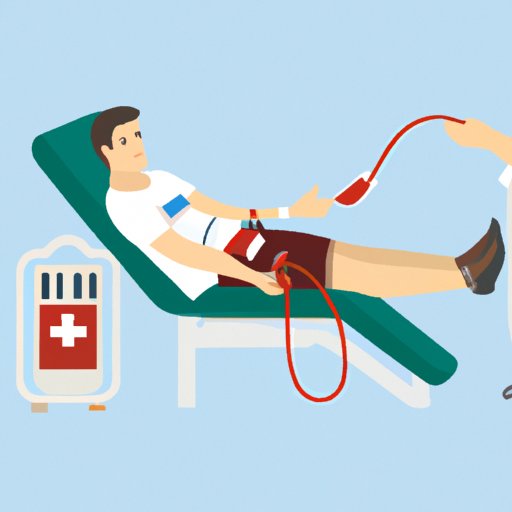Introduction
A blood transfusion is a medical procedure used to transfer blood or blood products from one person (or animal) to another. It’s an important treatment for a variety of medical conditions, including severe anemia, liver failure, cancer, and trauma. But how does a blood transfusion work? This article will explore the science behind blood transfusions, as well as the process for donating and receiving blood.

Exploring the Science Behind Blood Transfusions
Before we dive into how a blood transfusion works, let’s take a look at what blood is and why it’s so important. Blood is made up of red and white cells, platelets, proteins, and other components that help the body function properly. Red blood cells are responsible for carrying oxygen throughout the body, while white blood cells help fight infection. Platelets help with clotting, and proteins help regulate the body’s immune system.
When it comes to blood transfusions, it’s important to understand the different blood types. The most common blood type is A, followed by B and then O. There is also a rare type called AB, which is a combination of A and B. In order to ensure that a blood transfusion is successful, the donor and recipient must have compatible blood types.
A Step-by-Step Guide to Understanding How Blood Transfusions Work
Let’s take a look at a step-by-step guide to understanding how a blood transfusion works. First, donated blood is collected and tested for infectious diseases. Next, the patient is prepared for the transfusion by having their blood type and other vital signs checked. Then, the donated blood is administered through a needle and tube into the patient’s vein. Lastly, the patient is monitored for any adverse reactions.
Collecting and Testing Donated Blood
The first step in a blood transfusion is collecting and testing the donated blood. All donated blood is tested for infectious diseases such as HIV, hepatitis, syphilis, and others. The blood is also tested for compatibility with the recipient’s blood type. According to the American Red Cross, “Blood centers carefully test all donations for evidence of infection before releasing them for transfusion.”
Preparing the Patient for a Transfusion
Before the transfusion can be administered, the patient must be prepared. This includes checking their blood type and other vital signs, such as blood pressure and temperature. The patient may also be asked to sign a consent form to give permission for the procedure.
Administering the Transfusion
Once the patient is ready, the donated blood is administered through a needle and tube. The needle is inserted into a vein in the arm, and the blood is slowly delivered over a period of time. During the transfusion, the patient’s vital signs will be monitored to make sure there are no adverse reactions.
The Benefits and Risks of Blood Transfusions
Blood transfusions can be beneficial for many medical conditions, but there are also potential risks. Let’s take a look at the potential benefits and risks of blood transfusions.
Potential Benefits of Blood Transfusions
According to the National Institutes of Health, blood transfusions can provide several benefits, including:
- Replacing lost blood after surgery or trauma
- Treating anemia
- Preventing organ damage due to lack of oxygen
- Treating certain types of cancer
- Treating clotting disorders
Potential Risks of Blood Transfusions
Although blood transfusions can be beneficial, there are potential risks associated with the procedure. According to the World Health Organization, these risks include:
- Allergic reactions
- Transmission of infectious diseases, such as HIV and hepatitis
- Fluid overload
- Graft-versus-host disease
- Transfusion-related acute lung injury

An Overview of What Happens During a Blood Transfusion
Now that you know the potential benefits and risks of blood transfusions, let’s take a look at an overview of what happens during a blood transfusion.
Preparing the Blood
The first step is preparing the donated blood for transfusion. This includes testing the blood for infectious diseases and compatibility with the recipient’s blood type. Once the blood is prepared, it is stored in a special bag until it is ready to be used.
Inserting the Needle
Once the blood is prepared, a needle is inserted into a vein in the patient’s arm. The blood is then slowly delivered through a tube connected to the needle.
Monitoring the Patient
During the transfusion, the patient’s vital signs will be monitored to make sure there are no adverse reactions. The patient may experience some discomfort, but this is usually minimal.

Examining the Process for Donating and Receiving Blood for Transfusions
Let’s take a look at the process for donating and receiving blood for transfusions.
Donating Blood for Transfusions
Donating blood for transfusions is a safe and simple process. Potential donors must meet certain requirements, such as being in good health and meeting age and weight requirements. After donating, donors should make sure to drink plenty of fluids and eat a healthy meal.
Receiving Blood for Transfusions
Before receiving a blood transfusion, the patient must be cleared by a doctor. They must also be tested for compatibility with the donor’s blood type. During the transfusion, the patient’s vital signs will be monitored to make sure there are no adverse reactions.
Conclusion
Blood transfusions are an important medical procedure used to treat a variety of medical conditions. This article has explored the science behind blood transfusions, as well as the process for donating and receiving blood. We’ve also looked at the potential risks and benefits of blood transfusions.
In conclusion, blood transfusions are a safe and effective way to treat a variety of medical conditions. While there are potential risks associated with the procedure, these risks are minimized when proper safety protocols are followed. Ultimately, blood transfusions can save lives and improve quality of life for those in need.
(Note: Is this article not meeting your expectations? Do you have knowledge or insights to share? Unlock new opportunities and expand your reach by joining our authors team. Click Registration to join us and share your expertise with our readers.)
